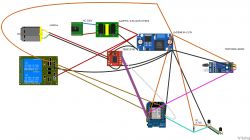Hi,
As a weekend hobby and to learn electronics, I decided to make a magnetic stirrer for yeast propagation.
The stirrer is to have motor speed control, speed measurement (as a fun addition), temperature measurement (ambient and liquid), cooling and heating control (relays) and in the future a touch screen (2,8" ILI9341).
Components
- The heart of the circuit is a Wemos D1 Mini (lion clone).
- For the power supply, I used a JustPi 5v/2.5A power supply. Connected to it was a 5A version of the LM2596 twisted to 3.3V.
- The motor is an rs550vs and is powered by 12v as standard. As it doesn't need that much RPM and torque I am powering it with 5v.
- The motor controller is: TB6612FNG. It uses one channel.
- I use a TCRT5000 LM393 reflection module to measure the speed.
- The relay module is a standard board with 2 relays from an arduino. As wemos operates on 3.3v and the relays on 5v, the board itself is additionally connected under 5v (instead of a jumper)
- The thermometers are standard ds18b20 with a 4.7k pull-up resistor
- I based the software on esphome. Easy configuration and integration with other software.
In theory, the circuit works fine. However, I have a few problems with it:
- after connecting the power supply, the motor always turns (about 1/2-1 turn) and only stops
- wemos does not always detect connected thermometers
- after connecting the thermometers the system resets. motor turns over, wemos starts from the beginning.
The starting action is so "painful" that I finally damaged the wemos in the tests.
What could be wrong? Which components in particular should I pay attention to for diagnostics?
 .
.
Many thanks in advance for your help! and apologies for the large number of connections in the picture
btw. once I have stabilised the solution I will want to add a touch screen to manage the whole thing safely.
As a weekend hobby and to learn electronics, I decided to make a magnetic stirrer for yeast propagation.
The stirrer is to have motor speed control, speed measurement (as a fun addition), temperature measurement (ambient and liquid), cooling and heating control (relays) and in the future a touch screen (2,8" ILI9341).
Components
- The heart of the circuit is a Wemos D1 Mini (lion clone).
- For the power supply, I used a JustPi 5v/2.5A power supply. Connected to it was a 5A version of the LM2596 twisted to 3.3V.
- The motor is an rs550vs and is powered by 12v as standard. As it doesn't need that much RPM and torque I am powering it with 5v.
- The motor controller is: TB6612FNG. It uses one channel.
- I use a TCRT5000 LM393 reflection module to measure the speed.
- The relay module is a standard board with 2 relays from an arduino. As wemos operates on 3.3v and the relays on 5v, the board itself is additionally connected under 5v (instead of a jumper)
- The thermometers are standard ds18b20 with a 4.7k pull-up resistor
- I based the software on esphome. Easy configuration and integration with other software.
In theory, the circuit works fine. However, I have a few problems with it:
- after connecting the power supply, the motor always turns (about 1/2-1 turn) and only stops
- wemos does not always detect connected thermometers
- after connecting the thermometers the system resets. motor turns over, wemos starts from the beginning.
The starting action is so "painful" that I finally damaged the wemos in the tests.
What could be wrong? Which components in particular should I pay attention to for diagnostics?
 .
.
Many thanks in advance for your help! and apologies for the large number of connections in the picture
btw. once I have stabilised the solution I will want to add a touch screen to manage the whole thing safely.





